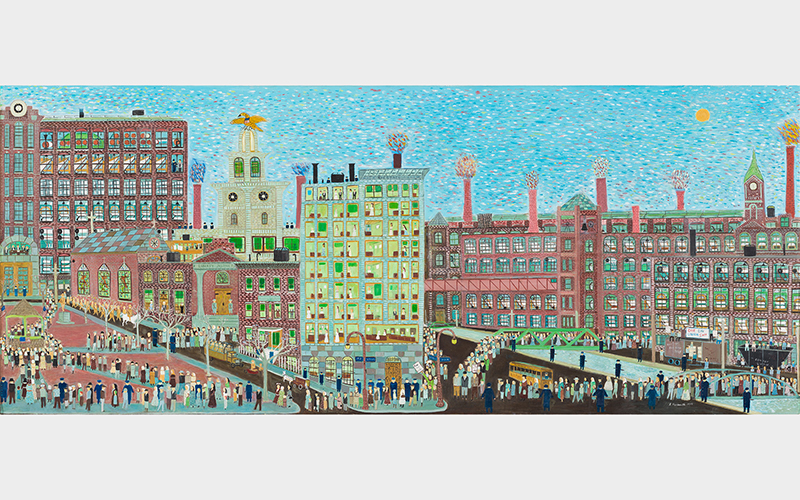
Ralph Fasanella (American, 1914–1997), Meeting at the Commons—Lawrence 1912, 1977, oil on canvas, 50 x 120 in. (127 x 304.8 cm), Collection of Richard Rosenthal, © Estate of Ralph Fasanella
Verbal Description
Hello, my name is Emily Holtrop, and I am the museum’s director of learning and interpretation. I will be reading the verbal description for Meeting at the Commons—Lawrence 1912 by Ralph Fasanella in Creating Connections: Self-Taught Artists in the Rosenthal Collection.
Ralph Fasanella was an American artist who lived from 1914 to 1977. His painting, Meeting at the Commons—Lawrence 1912, is an oil on canvas created in 1977. It is in the collection of Richard Rosenthal
Meeting at the Commons—Lawrence 1912 is a long, horizontally oriented painting measuring 50 by 120 inches or 127 by 304.8 centimeters. In this oil on canvas, Ralph Fasanella captures the scene of a textile workers’ strike in Lawrence, Massachusetts. Brick buildings extend all the way across the composition, beneath a sky painted in an intense light blue with flecks of red, white, and a darker blue. As this work is heavily detailed, we will start on the left and move across the image. In the left background is a tall seven-story brick building, of which we can only see part. On each floor, a bank of nine windows extends the length of the building. On the first level, yellow doors mark the building’s entrance. Above these doors is a lunette, an arched window through which we see men in dark suits sitting around a table. Outside, standing in front of the doors, are three men dressed in blue that, from their frontal poses, seem to be police officers or guards. Stretching out in front of this building into the picture’s foreground is a brown road and tree-lined, park-like space with a central gazebo with blue paths radiating from it. Dozens of people, both men and women, line the paths and parade across the painting’s foreground. A few of the protesters carry picket signs. Interspersed in the crowd are more police officers and soldiers. At left, in front of the aforementioned building, is a parade of armed soldiers led by a man on a white horse.
Moving to the center of the image, Fasanella includes several buildings beyond the park. The facilities, in red, white, and yellow brick, appear to be a church, a municipal building, and one that is perhaps housing. Among the structures, one particularly stands out. It is white brick with a dome topped by a gold eagle with a red, white, and blue breast. To the left of the white building, at the center of the painting, is a multistory building in light blue brick with curved streetlamps in front of it and a sign at the top that reads “Bay State.” This may be an office building, as desks and women wearing white dresses appear through the windows. In three of the topmost windows are pairs of adults looking out.
Finally, moving to the right side of the picture, we see a brown road and a canal separating the central buildings from a set of red brick, multistoried factories. Through the windows, we can see the textile looms, now stopped. Along the top of these structures are several smokestacks, each emitting a ball of colorful dots and dashes to suggest smoke. Numerous figures line the roads and the two bridges that cross the canal. A yellow bus, empty except for the driver, appears in the foreground. A trailer with a large sign on top that reads “One Big Union” stands in front of the factory building on the far side of the canal. A clock tower is near the very right of the picture.
Label Text
Hello, my name is Emily Holtrop, and I am the museum’s director of learning and interpretation. I will be reading the label for Meeting at the Commons—Lawrence 1912 by Ralph Fasanella in Creating Connections: Self-Taught Artists in the Rosenthal Collection.
Ralph Fasanella was an American artist who lived from 1914 to 1977. His painting, Meeting at the Commons-Lawrence, 1912, is an oil on canvas created in 1977. It is in the collection of Richard Rosenthal
In January 1912, textile workers in Lawrence, Massachusetts, went on strike to protest reductions in their hours and pay while the mills raked in enormous profits. The strikers, mostly immigrants employed in grueling jobs, swelled to more than 20,000. After more than two months, the so-called Bread and Roses Strike (named for a line in a James Oppenheim poem) pressured the mills to improve dangerous working conditions and the wages of factory employees.
Born two years after this event, Ralph Fasanella grew up in Brooklyn, New York, in an Italian immigrant family and became a labor organizer. His passionate dedication to social justice led to his reflection on history. Striving for accuracy, Fasanella visited Lawrence to study the buildings, conduct interviews, and pore through accounts. For Richard Rosenthal, this detailed, panoramic painting evokes memories of meeting the artist, with whom a shared love of the Brooklyn Dodgers broke the ice.
